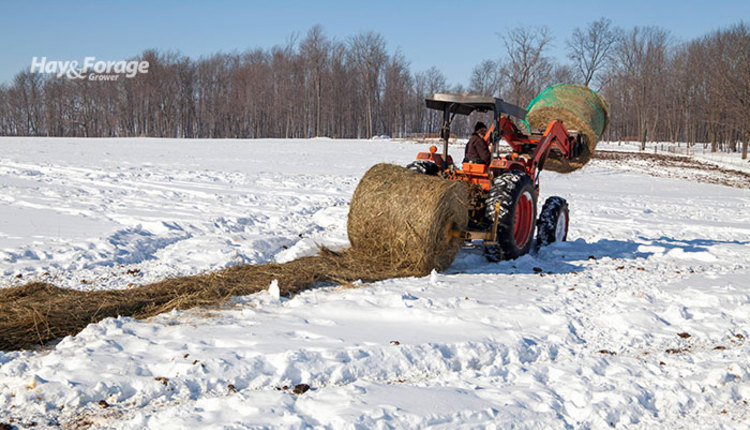Pick a winter feeding area with care |
| By Amber Friedrichsen, Associate Editor |
|
|
 Outdoor winter feeding areas are likely to take a beating. Heavy hoof traffic and manure accumulation can cause soil compaction, erosion, and excess nutrient buildup. Allotting unfit acres for winter feeding can also negatively affect animal health and performance. So, how can these problems be prevented? The answer comes down to proper planning. Steve Boyles with The Ohio State University advises producers to assess potential winter feeding areas based on their topography, soil characteristics, exposure to sunlight, and environmental sensitivity. Before considering these factors, though, first determine if a winter feeding area can meet the animals’ basic needs. “Basic needs such as access to water, adequate feed, shelter from high winds, and relatively dry soil conditions are all critical when selecting the area where livestock will be placed,” the extension beef specialist asserts. “If any of these basic needs cannot be met, the outdoor wintering system will not succeed.” Even if an area does meet these criteria, it still might not be a suitable location. Boyles explains how to evaluate the following factors in order to find the best patch of pasture for a successful outdoor winter feeding system. 1. Topography A field’s topography is defined by its slope, and Boyles says gentle to moderate slopes are the most ideal. Sites that are too flat can experience ponding and soil compaction, while sites that are too steep are subject to rapid water runoff and erosion. Ground level can affect winter feeding areas as well. High ground generally has better drainage, while drainage in low-lying areas is likely to be poor. The former can experience high winds that threaten animal performance, though, so Boyles suggests choosing land that is slightly elevated and has positive drainage and protection from surface water flow. 2. Soil characteristics In addition to topography, soil characteristics play an important role in water drainage. Boyles points out that soils can also vary in their ability to support weight and hold nutrients. He encourages producers to use soil survey data to understand soil characteristics of land that could be used for winter feeding. After locating a field on a soil map, notice the symbols used to identify different landscape features. These include streams, roads, sinkholes, and sandy and wet spots – all of which can influence the decision of where to conduct winter feeding. More information about these symbols can be found in the conventional and special symbols legend on the Index to Map Sheet of a soil survey report. 3. Sunlight Receiving sunlight from the south and southeast is beneficial to reduce soil moisture and elevate soil temperature, and it is also important for cattle comfort. Do not designate a winter feeding area in a location where the sun doesn’t shine. “Avoid areas with obstructions to the south, such as trees, hills, or buildings that could block sunlight,” Boyles advises. “Shaded areas will tend to be colder and slow to dry after rain or snowfall events.” 4. Environmentally sensitive areas Excess nutrients from manure can build up around winter feeding systems. These nutrients can run off with surface water and contaminate environmentally sensitive areas, which Boyles describes as stream corridors, springs or seeps, subsurface drainage tiles, ditches, and wellheads. The USDA Natural Resource Conservation Service Field Office Technical Guide (FOTG) provides recommendations for minimum distances between these environmentally sensitive areas and winter feeding systems. Wells, springs, streams, and other water courses require at least 100 feet of distance, while public wells must be at least 1,000 away. It is necessary to conduct annual soil testing to monitor soil fertility, especially if livestock are fed in the same location each year. In this case, nutrient buildup can be significant, threatening environmentally sensitive areas even more. Other considerations One solution to offset damage to centralized winter feeding areas is to install an asphalt or cement pad. This can alleviate soil compaction caused by livestock trampling the ground, which can also lead to plant death or thinning of stands. Therefore, a paved surface could promote plant growth come spring. Installing an asphalt or cement pad would also make for less mud, which could enhance livestock performance. “Mud 4 to 8 inches deep will reduce gain by 14%,” Boyles states. “Mud 8 to 24 inches deep will reduce gain by 25%.” Overall, deciding where to feed livestock in the winter requires substantial planning and deliberation. However, picking an appropriate location for a feeding area is key to safeguarding animals and the environment. “Outdoor wintering can be a tremendous cost-saving tool, but the environmental risks must be carefully evaluated,” Boyles concludes. “Time taken to properly locate an outdoor winter feeding area is time well spent.”  Amber Friedrichsen Amber Friedrichsen served as the 2021 Hay & Forage Grower editorial intern. She currently attends Iowa State University where she is majoring in agriculture and life sciences education-communications and agronomy. Friedrichsen grew up on her family’s diversified crop and livestock farm near Clinton, Iowa.
|
